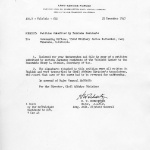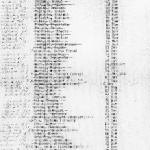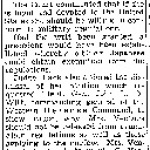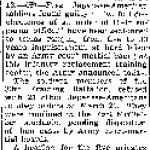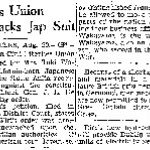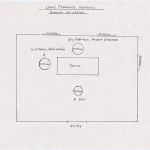Military resisters
Several different groups of Japanese American soldiers already in the army prior to Pearl Harbor refused combat training, citing the discriminatory treatment they received in the army and the incarceration of their families in American concentration camps. Some were court-martialed, dishonorably discharged, and served prison terms; others ended up in War Department Special Organizations assigned to perform manual labor. Largely omitted from the history of Japanese Americans in the military, the successful drive by some to secure honorable discharges brought greater attention to their story in the 1980s.
Some 5,000 Japanese Americans had been inducted in the army prior to the attack on Pearl Harbor and immediately after. [1] Viewed with great suspicion after the attack, their fate was left in the hands of their immediate commanders. Many were discharged, some honorably, some less than honorably. After serving as guards and performing civil defense tasks, 1,432 Nisei members of the Hawaii National Guard were famously formed into what would become the 100th Infantry Battalion . Some 1,440 Nisei remained in the army on the mainland. Prohibited from combat duty and training, most were assigned to menial tasks in various facilities across the country where they often faced harsh discrimination from commanders and colleagues. In a particularly galling example for many of the men, a group of Nisei stationed at Fort Riley, Kansas in 1943 were segregated and placed under armed guard during a visit by President Franklin D. Roosevelt .
Nonetheless, when combat training was opened up to the Nisei with the formation of the 442nd Regimental Combat Team in February of 1943, most of the prewar inductees opted for such training and became replacements for the 442nd. However, some 121 were assigned to a "Special Organization," the 525th Army Quartermaster Company, later reorganized as Company B of the 1800th Engineer General Service Battalion . Most were so assigned because they had refused combat training because of the way they had been treated in the army and because their families were being held in concentration camps; many also were deemed suspect because of prewar associations or because informants had fingered them. Deemed "semi-concentration camps," they performed menial hard labor in the 1800th for the duration of the war and were mostly given less than honorable discharges.
In March of 1944, 608 of the prewar inductees were transferred to Fort McClellan, Alabama for combat training. Within a week of their transfer, trouble began when 103 of the soldiers had to be confined in the stockade for disobedience. These men—almost of all of them Kibei —wanted to communicate their discomfort at being forced into combat training despite the discriminatory treatment they had received in the army as well as their families' incarceration in concentration camps. Many of these men had been part of the Fort Riley group who had been held under armed guard during FDR's visit. Given the opportunity to express their protest and report for combat training, most did. However, twenty-one refused further combat training and were eventually court-martialed for disobeying orders and issued harsh sentences of up to thirty years hard labor. These twenty-one became known as the "DB Boys" (Disciplinary Barrack Boys). The rest of the men at Fort McClellan underwent intense scrutiny and "loyalty" screening over the next few months, with seventy-six others eventually being transferred to Special Organizations, mostly the 1800th.
Thirty-one of the pre-Pearl Harbor draftees also asked to renounce their citizenship and to be sent back to Japan. All or nearly all were Kibei who had thus spent considerable time in Japan. Most of these were eventually sent to the 1800th. Eight who were in the 525th at Fort Leonard Wood in Missouri also refused to take part in training and were court-martialed, given dishonorable discharges and sentenced to fifteen years of hard labor. Their sentences were remitted in April of 1946, and they were released in December 1946.
Another sixteen renunciation requests came from soldiers at Fort Meade, Maryland, including eleven from the "Camp Grant Eleven." These eleven had served in a hospital at Camp Grant, Illinois for most of the war until anti-Japanese agitation—and the need for replacements for the 442nd—led to their being transferred for combat training. An intelligence officer who interviewed them summed up their attitude with one question: "Why should we fight for a country that has stripped us of property, denied us privileges enjoyed by other citizens, restricted our liberties, and given us no tangible evidence that our positions after the war will be any different that they are now?" [2] Refusing to report for training, the eleven were eventually court-martialed, given dishonorable discharges and sentenced to up to fifteen years of hard labor. Ten of the men were given another chance at combat duty, and four of them accepted. The other six—all of whom had family at Tule Lake —were tried again for refusing orders, found guilty, and sentenced to seven years of hard labor. Despite filing their renunciation after the "denaturalization" law had gone into effect, the men were not allowed to seek renunciation as stipulated by the law. The Fort Meade group ended up serving the longest prison terms, with some not being released until 1950.
The disparity in the sentencing of the DB Boys was noted and their sentences were reduced after the war and most were dishonorably discharged in June of 1946. Years of legal efforts after the war to revisit their trials and seek honorable discharges went for naught. However a renewed legal effort in the very different political climate of the 1980s led to eleven of the men having their discharges changed to honorable. (The other ten men had declined to participate.)
1970s reunions of the men of the 1800th organized by Kiyoshi Kawashima led to an effort to upgrade the "blue" (less than honorable) discharges that many men of the 1800th had received. Hyman Bravin, who had represented the men in their original discharge hearing in 1946—and who for all those years believed the men had been granted honorable discharges—took on their cases on a pro bono basis and over the next several years was able to secure honorable discharges for some forty men from the 1800th. This process was covered in the Japanese American press in the context of the redress movement and the general swing in community attitudes towards wartime resistance. However the military resisters of the 1800th, the DB Boys, and renunciants remain relatively little known relative to those who took part in draft resistance .
For More Information
Castelnuovo, Shirley. Soldiers of Conscience: Japanese American Military Resisters in World War II . Westport, Conn.: Praeger, 2008.
Tamura, Linda. Nisei Soldiers Break Their Silence: Coming Home to Hood River . Seattle: University of Washington Press, 2012.
Last updated July 14, 2014, 6:50 a.m..

